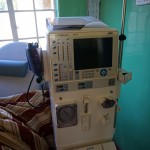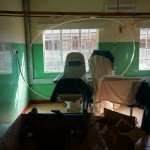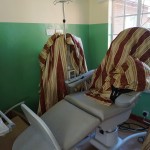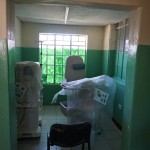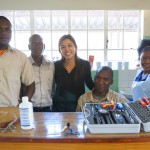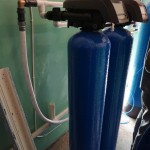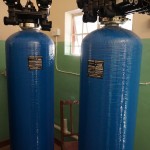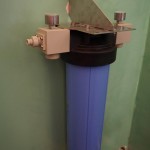Many people in the United States are familiar with diabetes, the devastating effects of kidney failure, and the impact dialysis has on everyday life. As a bioengineering student at Rice, my fundamentals of bioengineering class focused on the renal system for an entire semester, so I feel particularly well versed in this area. Before coming to Malawi I knew that:
- Diabetes Mellitus (aka diabetes) is a metabolic disease characterized by unusually high sugar in the blood stream
- Insulin is a protein provided within the body to remove excess sugar from the bloodstream
- Type 1 diabetes, which has an unknown cause, is due to the body’s failure to produce insulin.
- Type 2 diabetes, frequently caused by excess body weight and an unhealthy lifestyle, occurs when the body begins to fail to respond appropriately to insulin
- Long term effects of high blood sugar and diabetes can include end stage renal disease, the fifth stage of chronic kidney disease, a condition in which the body’s kidneys cease to function
- Other main causes of end stage renal disease are hypertension and inflammation of the kidneys
From these facts, I profiled the types of patients who would eventually need dialysis – a treatment in which a machine acts as a patient’s kidneys, filtering their blood and removing metabolic wastes from their system. To me, this patient would eat too much junk food, not exercise regularly, and frequently be overweight or obese. With this assumption in mind, I was surprised to walk into PAM this past Monday to be told that the technicians would be busy this week – occupied with the installation of five new dialysis machines at Queens!
Many of the Malawians I have seen eat significantly healthier than Americans, walk or bike everywhere, and are seldom overweight; I had never thought about the need for dialysis or the presence of diabetes as a pressing concern in the country. Though I did not assume that kidney failure was unheard of, I never stopped to think that it would be a significant enough problem that the Ministry of Health would invest resources in a dialysis center. Additionally, while Queens is certainly a high functioning hospital, many of the patients who come to Queens are referred from hospitals across the country. Dialysis is frequently a lifetime treatment, where patients need to come into the hospital at least once a week. For many Malawians, visiting the hospital this frequently, taking time off work and traveling long distances, would be incredibly difficult.
Eager to learn more about the dialysis center, Jacinta, Caleb and I headed off to ward 2B, planning to talk to the PAM technicians about the installation process. We were also interested in the reasoning behind the new installation and how the process of attending to patients on the machines would actually occur.
Fortunately, learning about the new dialysis machines was relatively straightforward. When we arrived at the installation site, Joshua, an engineer from Botswana, greeted us at the door. Discovering that we were engineering students, he was more than happy to give us a tour of the dialysis system. The ward itself was incredibly clean due to renovations for the new equipment. The walls were freshly painted, a new nursing station had been installed, and all of the equipment and chairs were brand new!
According to Joshua, the new dialysis center at Queens will have five stations, costing 3.6 million Kwacha per station – or about 900,000 USD. Four will be in a common dialysis center, and one will be an isolated dialysis station for patients infected with Hepatitis B. When the dialysate solution (a solution used to osmotically extract waste products from the blood) flows through the system, it passes through the Hep. B station last, ensuring that no contaminated solution is transferred to non-infected patients. When Caleb, Jacinta and I visited, the engineers (with the help of our PAM technician friends) were installing the water filtration system for the ward. To create ultra pure water, the water goes through five separate procedures, the number of particulates in the water decreasing after every step. Depending on the quality of the water being filtered, the filtration canisters will need to be serviced every five to ten years. Additionally, there are several safety mechanisms in place to ensure that no impure water is used in the dialysate solution. After he walked us through the installation process, Joshua invited us back on Friday to see the calibration for the machines; hopefully, we will be able to stop by tomorrow and see the final setup!
Unfortunately, figuring out how the new dialysis system will be implemented has proven to be relatively difficult. In talking to some of the physicians here, I have learned that, especially in African countries, end stage renal disease is an important co-morbidity of HIV, occasionally because of the direct impact HIV has on the kidney, or due to opportunistic kidney infections from HIV. (Struk et. al, 2011) – Due to the high prevalence of HIV in Malawi, I now have a better understanding as to why the Ministry of Health would invest money in these machines. However, I have not yet been able to figure out how patients will be treated. The center can treat around 40 patients in one working day, or about 300 patients a week. I am certain that there are more than 300 patients in Blantyre who could benefit from dialysis, not to mention patients throughout Malawi. Will these patients be treated on a first-come-first-serve basis? Will patients with chronic kidney failure be able to return to the clinic week after week, or will the clinic be open to acute patients who only need dialysis for the duration of their hospital stay? And how would being on dialysis impact the daily life of a Malawian? I have not been able to find the answers to any of these questions, but hopefully next week will provide me with the opportunity to talk to physicians involved in the project, getting more answers and understanding more about the Queens health care system.
